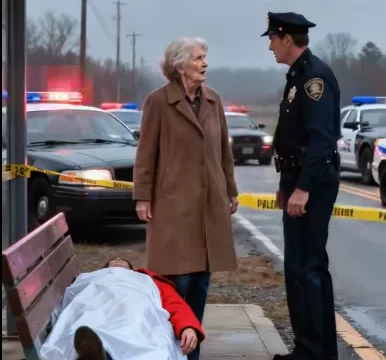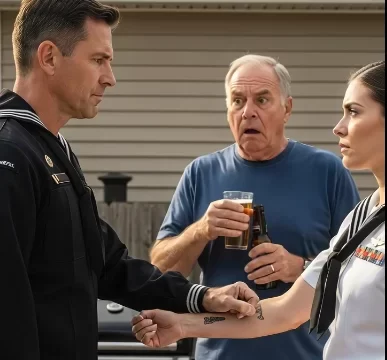The video lasts only a few seconds—shaky, muffled, and filled with the startled cries of a watching crowd. But in that brief moment, what unfolded on the streets of New York set off a firestorm of outrage, debate, and renewed scrutiny over one of the most contentious issues in America: the use of force by police. What might have been a routine arrest became a symbol of deeper questions about power, restraint, and accountability in an era where every encounter can be captured and shared with the world within minutes.

According to early reports and circulating footage, three New York police officers—two men and one woman—were attempting to arrest a woman in what appeared to be a standard enforcement situation. She was being guided to her knees to be handcuffed when another woman, her companion, suddenly stepped in. The second woman shoved the female officer, seemingly trying to disrupt the arrest. In that split second, one of the male officers reacted with a sharp kick to the woman’s torso, sending her backward and causing audible gasps from onlookers. The moment, caught on a bystander’s phone, quickly spread across social media—looped endlessly on TikTok, debated on Twitter, dissected on news panels, and rewatched millions of times by a polarized public.
The reaction was immediate and divided. Critics denounced the officer’s kick as an excessive, unnecessary act of aggression, particularly since the woman was unarmed and already surrounded by officers. To them, the move symbolized a broader issue—a pattern of police relying on force where patience, communication, or restraint might have been possible. Others defended the officer, arguing that when someone physically interferes with an arrest, officers must respond decisively to maintain control and protect themselves. “If you shove an officer, they can’t just wait to see what happens next,” one New Yorker said in defense. “In that moment, hesitation could lead to chaos.”
This divide reflects a national tension that has simmered for years: how to balance empathy for officers working under pressure with the public’s demand for transparency, restraint, and fairness. What some see as justified self-defense, others see as proof of systemic aggression—a lens that changes depending on one’s personal experience, race, or trust in law enforcement.
To understand the controversy, it’s important to look at how officers are trained. Across the United States, law enforcement agencies follow a “use-of-force continuum”—a scale outlining escalating responses based on perceived threat. It begins with officer presence and verbal commands, progresses to “soft” physical control like guiding or restraining, and then to intermediate tactics such as strikes, kicks, tasers, or pepper spray. The final, and most severe, level is deadly force. The officer’s action in New York falls into that intermediate category—typically reserved for situations where a clear, immediate threat exists. The question now under investigation is whether a shove met that threshold.
Courts will likely apply the “reasonable officer standard” established by the Supreme Court’s Graham v. Connor decision in 1989. Under this rule, officers’ actions are judged not by hindsight but by what a “reasonable officer on the scene” might perceive at that moment. This legal benchmark gives officers a degree of protection, acknowledging the split-second nature of their decisions—but it also leaves vast room for interpretation, which is why similar cases so often divide juries, judges, and the public alike.
The NYPD confirmed that an internal investigation is underway. Such inquiries typically involve reviewing body-camera footage, analyzing witness statements, collecting bystander videos, and consulting department use-of-force experts. Possible outcomes could range from exoneration and retraining to suspension or termination. In rare cases, criminal charges may follow. Yet regardless of the result, public trust is once again on the line—especially in neighborhoods where confidence in police fairness is already thin.
Why do incidents like this resonate so deeply? Because they touch on core themes of power, justice, and identity. The public debate extends far beyond the few seconds of footage. It’s about how much force is acceptable, how much context matters, and how society defines accountability in the digital age. For many, the outrage isn’t about one officer’s actions—it’s about a long history of mistrust. From Rodney King in 1991 to George Floyd in 2020, high-profile cases have built a collective memory of fear and frustration. Each new video, no matter how different, becomes another chapter in that story.
The New York incident has reignited calls for reform: more de-escalation training, greater emphasis on mental health response teams, and expanded community policing initiatives. Advocates argue that officers need more non-violent tools to manage volatile situations. They say real safety comes not from dominance, but from communication, empathy, and mutual respect. Opponents of reform warn that policing is inherently unpredictable and dangerous, and hesitation could put officers or bystanders at risk. “We can’t train hesitation into people who have to make split-second life-or-death decisions,” said one police union representative. Both perspectives reveal the delicate balance at the heart of this national conversation: protecting both citizens’ rights and officers’ safety without tipping too far in either direction.
Technology has made that balance even more complex. In the era of smartphones, every public action by police is subject to instant scrutiny. Supporters of this transparency say it’s an essential safeguard against abuse, a way to hold power accountable in real time. Critics counter that viral clips often lack context and can fuel outrage before facts are known. Still, the world has changed. Every officer now works not only under the authority of the law, but under the lens of millions of viewers who serve as global witnesses to every decision made in uniform.
Although this specific case occurred in New York, its implications stretch across the country. Cities like Los Angeles, Chicago, and Minneapolis face similar tensions and public skepticism. Each new viral video reignites the same questions: What does “reasonable force” really look like in the moment? How do we ensure accountability without handcuffing those sworn to protect us? And perhaps most importantly, can trust be rebuilt in communities where it’s been fractured for generations?
The story of this arrest is still unfolding. Investigations will determine whether policy was violated or justified. Disciplinary action may follow—or the officer may be cleared entirely. But the video has already taken on a life of its own. It is no longer just evidence in an internal review. It has become a symbol—a mirror reflecting the fragile balance between authority and responsibility in modern America.
For now, the country watches and waits, once again forced to confront uncomfortable truths about its systems of justice. The incident in New York isn’t just about one officer’s reaction or one woman’s shove. It’s about the unspoken agreement between law enforcement and the public they serve—a social contract built on trust, fairness, and restraint. Every time that agreement is tested, the entire nation feels it.
Because every act of force, whether justified or excessive, echoes far beyond the street where it happens. It shapes how people see authority, how communities view safety, and how America defines justice itself. The video may last only seconds, but its impact will linger for years—a reminder that in every moment of control lies the responsibility to wield power with humanity.





